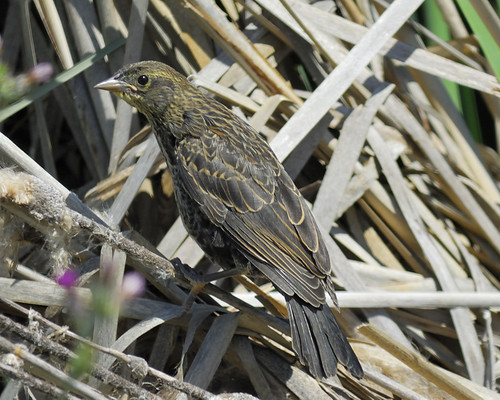tags: Bicolored Blackbird, Agelaius phoeniceus gubernator, birds, mystery bird, bird ID quiz
[Mystery bird] Fledgling Bicolored Blackbird, Agelaius phoeniceus gubernator, photographed at Las Gallinas Wildlife Ponds, Marin County, California. [I will identify this bird for you in 48 hours]
Image: Joseph Kennedy, 13 May 2010 [larger view].
Nikon D200, Kowa 883 telescope with TSN-PZ camera eyepiece 1/500s f/8.0 at 1000.0mm iso400.
Please name at least one field mark that supports your identification.
This mystery bird is quite challenging to identify, but for those of you who can ID this species, can you also tell me the subspecies?
The Bicolored Blackbird, Agelaius phoeniceus gubernator, of California and central Mexico is a distinctive subspecies of the Red-winged Blackbird, A. p. phoeniceus. The male lacks the yellow wing patch of the nominate race, and the female is much darker than the female nominate. The taxonomy of this form is little understood, with the relationships between the two isolated Bicolored Blackbird populations, and between these and Red-winged Blackbirds still unclear.
- Log in to post comments


Looks like a juvenile of the subspecies gubernator, based on the thick bill, dark undersides, and rufous hints on the scapulars
I'm thinking a blackbird, either a Redwing or a Tri-color, but it could be a female or first year bird?
I grew up in an area where the Redwings only have the red patch, and it still seems weird to me that the ones with red and yellow on the patch are the same species.
The more brownish along the feather edges and the orangish chin make me think a female red wing. I don't know any subspecies, though.
Agelaius phoeniceus gubernator (psweet, sorry, "gubernator" is not a subspecies. It's just a random word. It only counts as a subspecies with teh A. p. in front of it, otherwise you may well be talking about the Gubernor of California, Arnold Schwarzenegger.
My tortured reasoning:
It is a blackbird female because it has the blacbird female morphotype.
It does NOT have a yellow beak or certain other features, so it is not one of those other blackbirds. It's a redwing blackbird sort of blackbird.
It has a dark (darker than usual) cheek patch and a reasonably distinct (for a female bb) eye stripe.
It is not a tri-colored blakcbird, because, following one of your hints, there are no subspecies of tri-colored blackbird.
Most redwing subspecies have been shown to be invalid (they result from reaction norms). But I think the bicolored is considered valid, and lives in California, so following your other hint, I'd go with that one.
i think it's safe to say that we can identify where bardiac grew up within a few hundred miles ... maybe that should be a mystery bird feature? i can ask each of my mystery bird fans to choose a bird that is unique to where they live or grew up, and we can identify where that place is ...
this is a variation of a game i played with my seattle birding pals when i traveled: i'd show them some photos of birds (one per day) and ask them to identify where in the world i was by the birds i was photographing to show them. it was a contest to see who could identify within 100 miles or less where i was, and who could make the most reasonable identification after seeing the fewest bird images. it was rather fun, i thought, and lots of people "played", too.
Greg wrote: "It does NOT have a yellow beak"
No, but it has a yellow GAPE (think of this as the corners of the mouth), which means it is a juvenile bird. And in many passerines, the juvenile plumages resemble the females most closely, so we don't know what the sex of this bird is.
But I agree with Greg about the species ID.
I know (about where I grew up).
The cool thing is, I haven't really looked at Redwing Blackbirds in my bird book or on line since I first learned the basic bird, but I did today. So now I realize there's a subspecies where I grew up. I'd never quite put that together before. It might surprise you how often it happens when I'm trying to look up birds for the mystery bird that I learn a little something about a bird I already "knew" on a basic level. It's very cool.
bardiac: i cannot tell you how many times i get "lost" on the internet while searching for something or other. i am sure the same thing happens to each of you, too. so i decided that i would use this to my advantage by asking questions that are interesting but also are vague enough that it'll keep you reading and looking around and thinking, "is this what she's asking me for? or maybe this other thing is what she wants?"
i do this specifically so you all become more immersed into the lore and literature of birds, birding and ornithology. many of you report back here, too, which is even better so we can then learn from what you've learned.
Greg, I'll accept your taxonomic correction -- but point out that by using the inaccurate method I did allowed an attempt at answering the subspecies question without giving away the ID for those who still want to try. I'd like to think that that qualifies as what Jack Cohen and Ian Stewart call "lies to children".
Where I come from, there is only one blackbird, and a redwing is one of these.
psweet: Good point, I had not thought of that. I was blinded in my efforts to win the prize!!!!